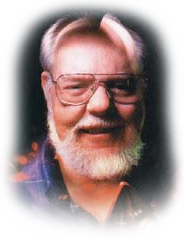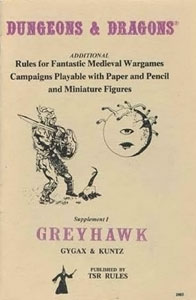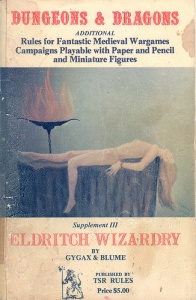Greyhawk, also known as the World of Greyhawk, is a fictional world designed as a campaign setting for the Dungeons & Dragons fantasy roleplaying game. Although not the first campaign world developed for Dungeons & Dragons—Dave Arneson's Blackmoor campaign predated it by about a year—the world of Greyhawk closely identified with early development of the game beginning in 1972, and after being published it remained associated with Dungeons & Dragons publications until 2008. The world itself started as a simple dungeon under a castle designed by Gary Gygax for the amusement of his children and friends, but it was rapidly expanded to include not only a complex multi-layered dungeon environment, but also the nearby city of Greyhawk, and eventually an entire world. In addition to the campaign world, which was published in several editions over twenty years, Greyhawk was also used as the setting for many adventures published in support of the game, as well as for RPGA's massively shared Living Greyhawk campaign from 2000–2008.

David Lance Arneson was an American game designer best known for co-developing the first published role-playing game (RPG), Dungeons & Dragons, with Gary Gygax, in the early 1970s. Arneson's early work was fundamental to the role-playing game (RPG) genre, pioneering devices now considered to be archetypical, such as cooperative play to develop a storyline instead of individual competitive play to "win" and adventuring in dungeon, town, and wilderness settings as presented by a neutral judge who doubles as the voice and consciousness of all characters aside from the player characters.

Vecna is a fictional character appearing in the Dungeons & Dragons fantasy role-playing game. Vecna has been named one of the greatest villains in the Dungeons & Dragons franchise.

The Monster Manual is the primary bestiary sourcebook for monsters in the Dungeons & Dragons fantasy role-playing game, first published in 1977 by TSR. The Monster Manual was the first hardcover D&D book and includes monsters derived from mythology and folklore, as well as creatures created specifically for D&D. Creature descriptions include game-specific statistics, a brief description of its habits and habitats, and typically an image of the creature. Along with the Player's Handbook and Dungeon Master's Guide, the Monster Manual is one of the three "core rulebooks" in most editions of the D&D game. As such, new editions of the Monster Manual have been released for each edition of D&D. Due to the level of detail and illustration included in the 1977 release, the book was cited as a pivotal example of a new style of wargame books. Future editions would draw on various sources and act as a compendium of published monsters.

An owlbear is a fictional creature originally created for the Dungeons & Dragons fantasy role-playing game. An owlbear is depicted as a cross between a bear and an owl, which "hugs" like a bear and attacks with its beak. Inspired by a plastic toy made in Hong Kong, Gary Gygax created the owlbear and introduced the creature to the game in the 1975 Greyhawk supplement; the creature has since appeared in every subsequent edition of the game. Owlbears, or similar beasts, also appear in several other fantasy role-playing games, video games and other media.
Several different editions of the Dungeons & Dragons (D&D) fantasy role-playing game have been produced since 1974. The current publisher of D&D, Wizards of the Coast, produces new materials only for the most current edition of the game. However, many D&D fans continue to play older versions of the game and some third-party companies continue to publish materials compatible with these older editions.

The lich is an undead creature found in the Dungeons & Dragons (D&D) fantasy role-playing game. Liches are spellcasters who seek to defy death by magical means.
Tritons are a fictional species in the Dungeons & Dragons fantasy role-playing game.

Robert J. Kuntz is a game designer and author of role-playing game publications. He is best known for his contributions to various Dungeons & Dragons-related materials.

Gods, Demi-Gods & Heroes is a supplementary rulebook for the Dungeons & Dragons (D&D) fantasy role-playing game. Its product designation is TSR 2006.
In the Dungeons & Dragons fantasy roleplaying game, the intellect devourer is a type of fictional monster.

The original Dungeons & Dragons boxed set by Gary Gygax and Dave Arneson was published by TSR, Inc. in 1974. It included the original edition of the Dungeons & Dragons fantasy role-playing game. Its product designation was TSR 2002.

Greyhawk is a supplementary rulebook written by Gary Gygax and Robert J. Kuntz for the original edition of the Dungeons & Dragons (D&D) fantasy role-playing game. It has been called "the first and most important supplement" to the original D&D rules. Although the name of the book was taken from the home campaign supervised by Gygax and Kuntz based on Gygax's imagined Castle Greyhawk and the lands surrounding it, Greyhawk did not give any details of the castle or the campaign world; instead, it explained the rules that Gygax and Kuntz used in their home campaign, and introduced a number of character classes, spells, concepts and monsters used in all subsequent editions of D&D.

Blackmoor is a supplementary rulebook of the original edition of the Dungeons & Dragons fantasy role-playing game written by Dave Arneson.

Swords & Spells is a supplementary rulebook by Gary Gygax for the original edition of the Dungeons & Dragons fantasy role-playing game. Its product designation is TSR 2007.
Timothy James Kask is an American editor and writer in the role-playing game industry. Kask became interested in board games in his childhood, and later turned to miniatures wargames. While attending university after a stint in the US Navy, he was part of a group that playtested an early version of the new role-playing game Dungeons & Dragons (D&D) for game co-designer Gary Gygax. Gygax hired him as the first employee of TSR, Inc. in 1975. After editing some of TSR's early D&D publications, Kask became editor of The Strategic Review, which later became The Dragon, and then Dragon Magazine.
Brian John Blume was an American game designer and writer, principally known as a former business partner of Gary Gygax at TSR, Inc., original publishers of the fantasy role-playing game Dungeons & Dragons.

The Book of Artifacts is a supplemental sourcebook to the core rules of the second edition of the Advanced Dungeons & Dragons fantasy role-playing game. This book, published by TSR, Inc. in 1993, details 50 different artifacts, special magic items found within the game at the Dungeon Master's option. The book was designed primarily by David "Zeb" Cook, with some additional design by Rich Baker, Wolfgang Baur, Steve and Glenda Burns, Bill Connors, Dale "Slade" Henson, Colin McComb, Thomas M. Reid, and David Wise. Cover art is by Fred Fields and interior art and icons were designed by Daniel Frazier.
The Wand of Orcus is a fictional magical weapon described in various Dungeons & Dragons media. Because of the popularity of Orcus as a villain within the Dungeons & Dragons universe, many different authors have written materials describing artifacts created by or associated with the character. The Wand of Orcus is consistently the most important and most described of these artifacts. Screen Rant has noted that "[t]he weapon that Orcus wields in battle is almost as famous as the demon lord himself". Furthermore, the device has at times been employed in books, games, and other media within the franchise as a thing distinct from Orcus himself, such that adventurers may encounter the wand as a freestanding element of the game or story.

Stephen R. "Steve" Marsh is an American game designer and lawyer best known for his contributions to early editions of TSR's Dungeons & Dragons fantasy tabletop role-playing game (RPG). Some of the creatures he created for the original edition of D&D in 1975 have been included in every subsequent edition of the game.











